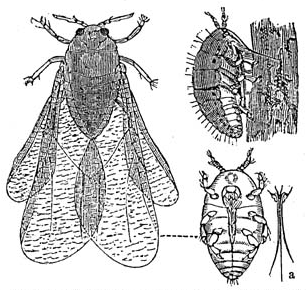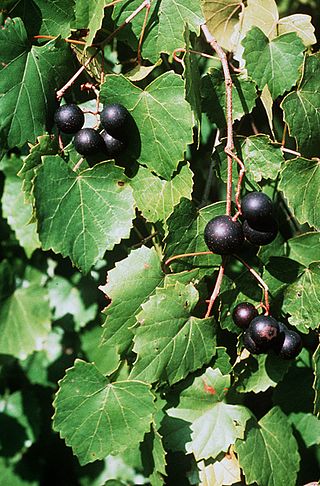
A grape is a fruit, botanically a berry, of the deciduous woody vines of the flowering plant genus Vitis. Grapes are a non-climacteric type of fruit, generally occurring in clusters.

Vaccinium vitis-idaea is a small evergreen shrub in the heath family, Ericaceae. It is known colloquially as the lingonberry, partridgeberry, foxberry, mountain cranberry, or cowberry. It is native to boreal forest and Arctic tundra throughout the Northern Hemisphere. Commercially cultivated in the United States Pacific Northwest and the Netherlands, the edible berries are also picked in the wild and used in various dishes, especially in Nordic cuisine.

Grape phylloxera is an insect pest of grapevines worldwide, originally native to eastern North America. Grape phylloxera ; originally described in France as Phylloxera vastatrix; equated to the previously described Daktulosphaera vitifoliae, Phylloxera vitifoliae. The insect is commonly just called phylloxera.

Vitis vinifera, the common grape vine, is a species of flowering plant, native to the Mediterranean region, Central Europe, and southwestern Asia, from Morocco and Portugal north to southern Germany and east to northern Iran. As of 2012, there were between 5,000 and 10,000 varieties of Vitis vinifera grapes though only a few are of commercial significance for wine and table grape production.

Vitis rotundifolia, or muscadine, is a grapevine species native to the southeastern and south-central United States. The growth range extends from Florida to New Jersey coast, and west to eastern Texas and Oklahoma. It has been extensively cultivated since the 16th century. The plants are well-adapted to their native warm and humid climate; they need fewer chilling hours than better known varieties, and thrive in summer heat.

In botany, chlorosis is a condition in which leaves produce insufficient chlorophyll. As chlorophyll is responsible for the green color of leaves, chlorotic leaves are pale, yellow, or yellow-white. The affected plant has little or no ability to manufacture carbohydrates through photosynthesis and may die unless the cause of its chlorophyll insufficiency is treated and this may lead to a plant disease called rusts, although some chlorotic plants, such as the albino Arabidopsis thaliana mutant ppi2, are viable if supplied with exogenous sucrose.

Vitis amurensis, the Amur grape, is a species of grape native to the Asian continent. Its name comes from the Amur Valley in Russia and China.

Hybrid grapes are grape varieties that are the product of a crossing of two or more Vitis species. This is in contrast to crossings between grape varieties of the same species, typically Vitis vinifera, the European grapevine. Hybrid grapes are also referred to as inter-species crossings or "Modern Varieties." Due to their often excellent tolerance to powdery mildew, other fungal diseases, nematodes, and phylloxera, hybrid varieties have, to some extent, become a renewed focus for European breeding programs. The recently developed varieties are examples of newer hybrid grape varieties for European viticulturalists. Several North American breeding programs, such as those at Cornell and the University of Minnesota, focus exclusively on hybrid grapes, with active and successful programs, having created hundreds if not thousands of new varieties.

Rondo is a dark-skinned grape variety, used for making red wine. It is a hybrid grape or inter-specific crossing. It was created in 1964 by Professor Vilém Kraus in then-Czechoslovakia by crossing the varieties Zarya Severa and St. Laurent. He offered it to Dr. Helmut Becker (1927-1990) of the Geisenheim Grape Breeding Institute who conducted further work on it, which explains why the grape is known under a Geisenheim designation. The variety was first planted for research and later in bigger scale in the mid 1980s by Thomas Walk Vineyard in Ireland under the name Amurensis Walk; it was named Rondo in 1997.

Vitis (grapevine) is a genus of 81 accepted species of vining plants in the flowering plant family Vitaceae. The genus consists of species predominantly from the Northern Hemisphere. It is economically important as the source of grapes, both for direct consumption of the fruit and for fermentation to produce wine. The study and cultivation of grapevines is called viticulture.
Hopea malibato is a species of plant in the family Dipterocarpaceae. It is endemic to the Philippines.
Severny is the name of a Russian red-grape variety. Severny results from the interspecific crossing between Seianetze Malengra and Vitis amurensis. The hybrid has been obtained in the Institute for wineyard researches in Rostov-on-Don in Russia. The hybrid was crossed in 1936 by the breeder Ya. I. Potapenko and E. Zakharova in Rostov. The variety has been imported to Finger Lakes AVA, just south of Lake Ontario, in the United States.

Bronner is a white grape variety used for wine. It was bred in 1975 by Norbert Becker at the viticultural institute in Freiburg, Germany. The variety was initially known under its breeding code FR 250-75, and was later named in honour of Johann Philipp Bronner (1792-1864), who was a German pharmacist and viticultural pioneer. It received varietal protection in 1977.

Theretra japonica is a moth of the family Sphingidae first described by Jean Baptiste Boisduval in 1869.
Vitis acerifolia is a species of grape native to the south-central part of the Great Plains of the United States. Its leaf shape is the origin of its name, which is Latin for maple-leaf grape, but it is widely referenced in literature by the synonym, Vitis longii.

Amurensin K is an oligostilbene. It is a resveratrol tetramer found in Vitis amurensis. Preliminary tests have shown it to be an effective neuraminidase inhibitor against the influenza A virus subtype H1N1.

Quadrangularin A is an oligostilbene found in Cissus quadrangularis and in Parthenocissus laetevirens. It is a resveratrol dimer.

Amurensin E is an oligostilbene found in Vitis amurensis. It is a pentamer of resveratrol.
Zarya severa is a red grape variety. It is a descendant of the Asiatic wild grape Vitis amurensis and the grape Malingre Précoce of French origin and is thus a hybrid vine. The crossing took place at the Potapenko Viticulture Research Institute in Rostov Oblast, Russia in 1936. Because of its high winter frost resistance as well as its resistance to downy mildew, this variety, often mentioned by breeders in Eastern Europe, became a major breeding stock in the search for new varieties.















